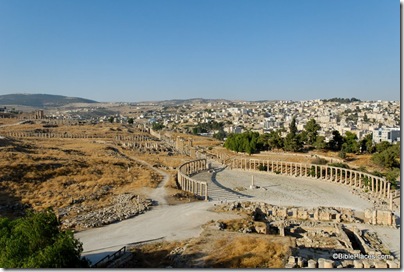“Of Jerash we may say generally, it is the best preserved of all the ruined cities east of Jordan. The ruins are weather-worn and beaten with the storms of centuries; earthquakes have shaken down many once splendid buildings, but there were no traces of the destroying hand of man” (William Ewing, Arab and Druze at Home, 1907).
“It is very noticeable that the ruins of Jerâsh up to the present day have been but little disturbed.
There has never been any great Moslem city in its neighbourhood, and hence its columns remain in situ or, thrown down by the earthquake, sprawling along the ground, while the stones of the Great Temple of the Sun and of the theatres are fortunate in having been, as yet, unpilfered for building material. Further, since there is in these regions no sand to drift over and veil the outlines, and the frequent drought preventing the ruins from becoming masked by vegetation, all that remains stands out, white and glaring, in noontide, having that same appearance of recent desolation which is so striking a characteristic of a freshly cleared streets of Pompeii” (Guy Le Strange, “Account of a Short Journey East of the Jordan,” Palestine Exploration Fund Quarterly Statement, 1885).
The top photo and both quotations are taken from the Lebanon, Syria, and Jordan volume of The American Colony and Eric Matson Collection (Library of Congress, LC-matpc-02743).

